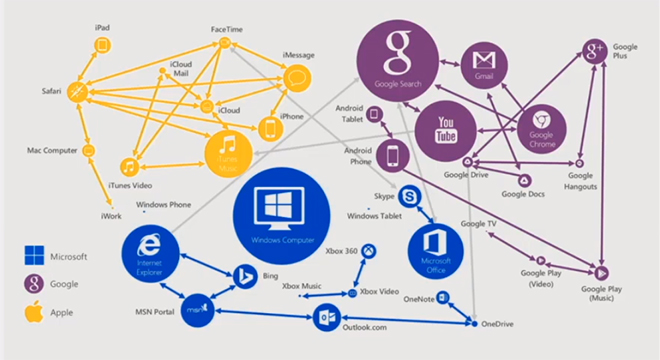Microsoft has been doing some surprising things with software over the past year. Free Windows and Windows Phone licenses for PC and phone makers, free Office for iOS and Android, and acquisitions of free mobile apps all come to mind. While Microsoft has been praised for its bold moves, one question remains: how will Microsoft make money if it gives away software? The answer is freemium.
Microsoft’s traditional revenue has primarily come from licensing software like Windows and Office to OEMs and businesses. Microsoft grew into the giant it is today thanks to this hugely successful strategy and a dominance of the PC market. With mobile altering the landscape, Microsoft is turning to new strategies for the future of its entire business. Speaking at Microsoft’s Convergence conference today, Chris Caposella, who is in charge of marketing at the software giant, revealed Microsoft’s freemium plans in full.
Freemium is the way forward
It involves four parts: acquire, engage, enlist, and monetize. Acquire is Microsoft's way of getting people to use a product for free, like Office for iPad. Engage is Microsoft’s plan to get them hooked on the product and leverage other parts of its ecosystem to keep someone using the service. Enlist is simply finding fans to keep the circle going, and then monetizing is figuring out who will pay for subscription versions of the service they’re hooked on. It sounds simple, but it’s something Microsoft hasn’t traditionally succeeded at. Google has thrived at offering free services in return for your data or ads, but Microsoft’s approach assumes people are willing to spend money on apps and services they’re addicted to.

Caposella’s talk marks the first time Microsoft has clearly signalled exactly how it will rival Apple and Google’s ecosystems. Former Microsoft CEO Steve Ballmer hinted at it during his final months, but Caposella used an illustration of all three companies’ greatest assets to show where Microsoft is focusing its efforts. "If you look what Apple advertises on TV, at least in the US, it’s all iPhone and iPad, and yet you see all the lines that connect their ecosystem," explains Caposella. "So they can focus their marketing dollars on a very small number of things, be very disciplined, but because they’ve engineered their things to work together one product naturally leads to the next product without any marketing at all. Very efficient marketing to build your marketing into your products."
Microsoft is taking an Apple approach to product integration
It’s a technique that Microsoft has started to adopt, admits Caposella. Citing the Surface Pro 3 and its deep integration with OneNote, Microsoft has seen a big increase in OneNote usage. "We had to convince the Windows team to work with the Surface team to work with the OneNote team," says Caposella, but the result was a product tied to Microsoft’s strengths. Elsewhere, Cortana feeds into Bing to break the Google addiction. "If you use Cortana, you’re actually becoming a Bing user," explains Caposella. "This is a way I can build Bing into every Windows phone, into every Windows 10 PC." While breaking the familiarity of using Google’s website to search might be difficult, slowly spreading Cortana into apps and services across Microsoft’s products will certainly help draw people away. Microsoft is using the same techniques for Outlook.com by integrating Skype in the hope you’ll become a Skype user and they can then sell you minutes or subscriptions.

"We know consumers are choosing an ecosystem more than ever," admits Caposella, and it’s this notion of an ecosystem that Microsoft really wants to improve. "We don’t have nearly the connectivity between our products that Apple has engineered, that Google has engineered." That’s illustrated well in Microsoft’s slide, and it’s a good reminder that the company has a lot of work ahead of it to bring its products closer together. Windows 10 will obviously help a lot, and its primary purpose is unifying the apps, services, and the devices themselves on a single operating system. Windows 10 isn’t the savior of Microsoft, though. It will certainly lay a foundation for better interconnectivity between Microsoft’s apps and services across Windows, but as the company continues to focus on iOS and Android it will be looking to find every opportunity to break any addiction to Google’s and Apple’s strong ecosystems.
Verge Video: Hands-on with Windows 10
:format(webp)/cdn.vox-cdn.com/uploads/chorus_asset/file/15299242/microsoftstock.0.0.1426547672.jpg)